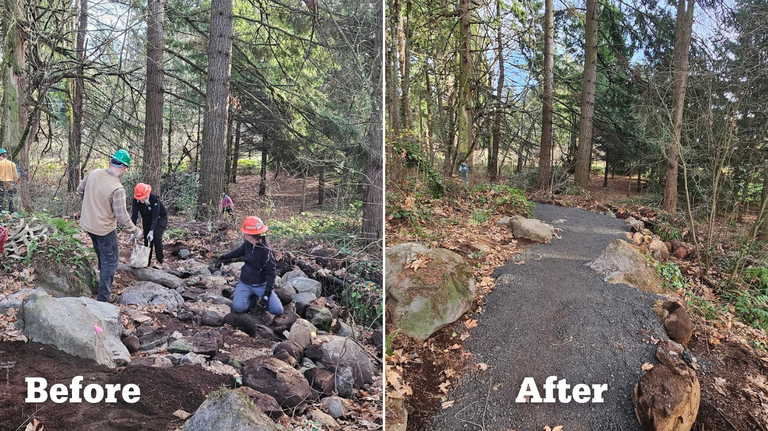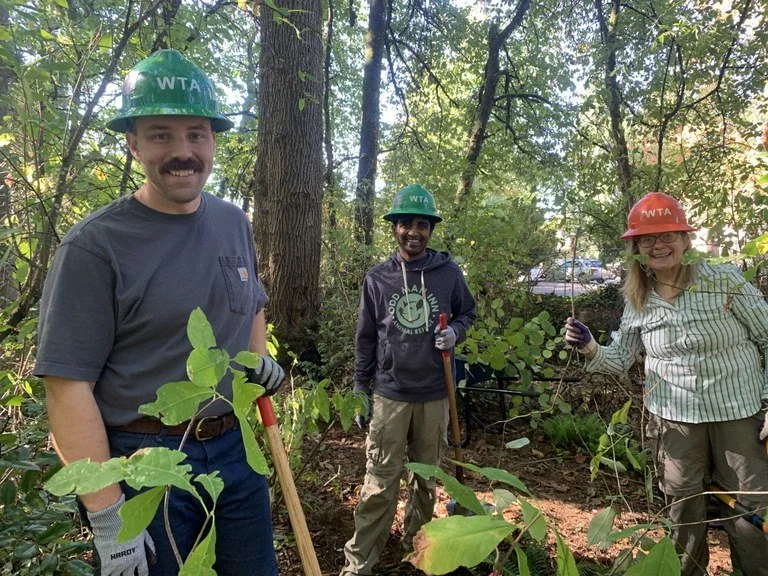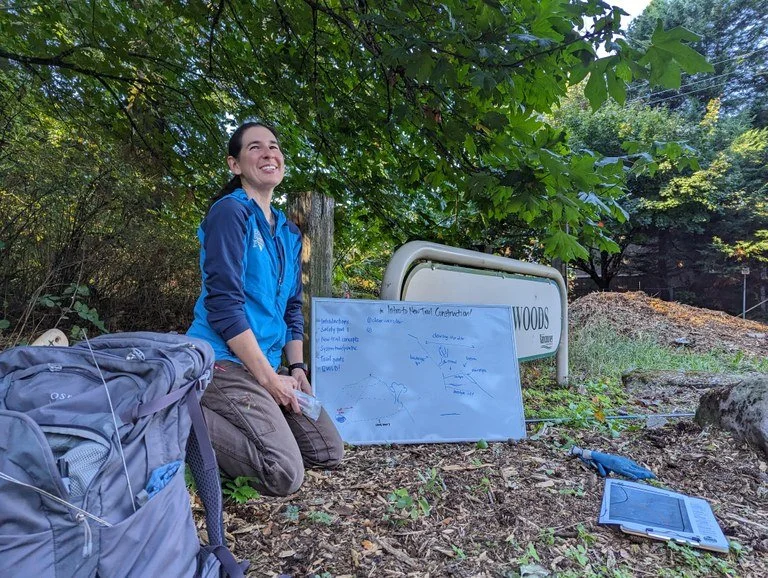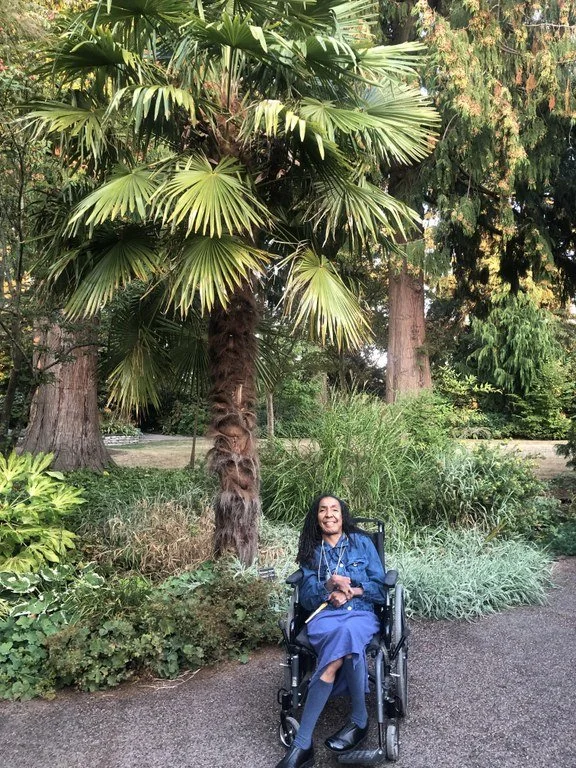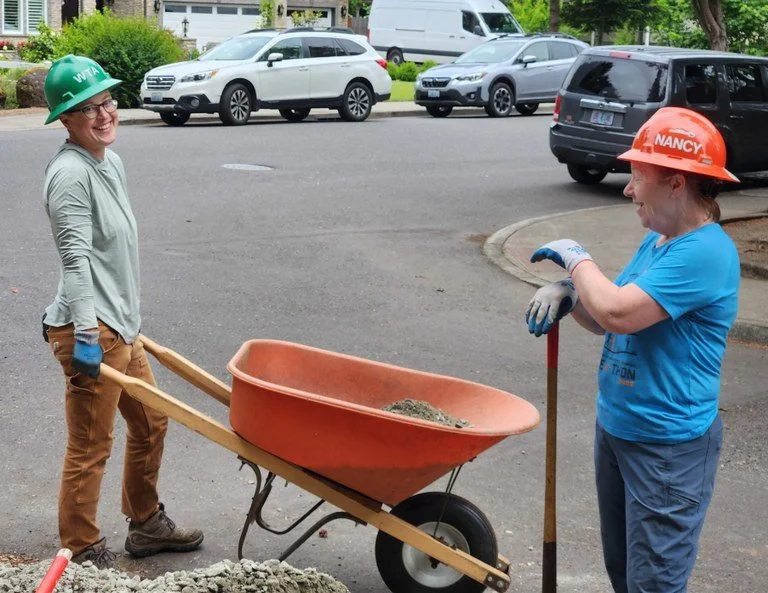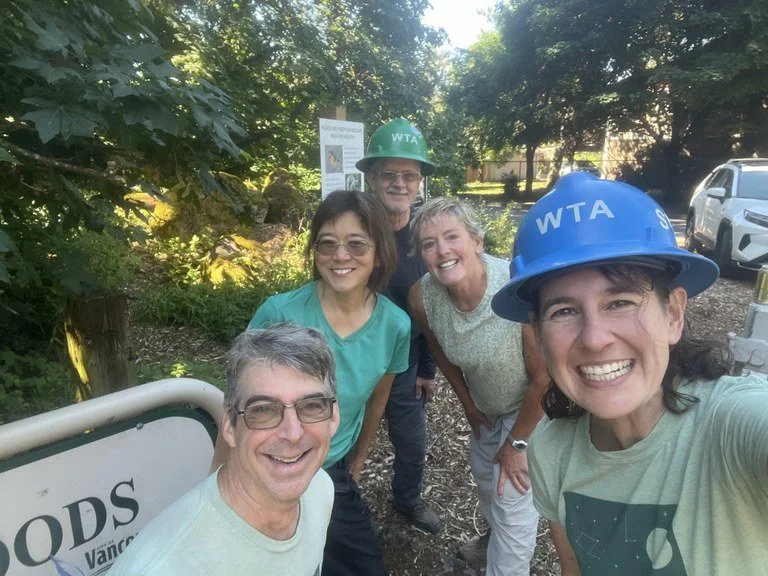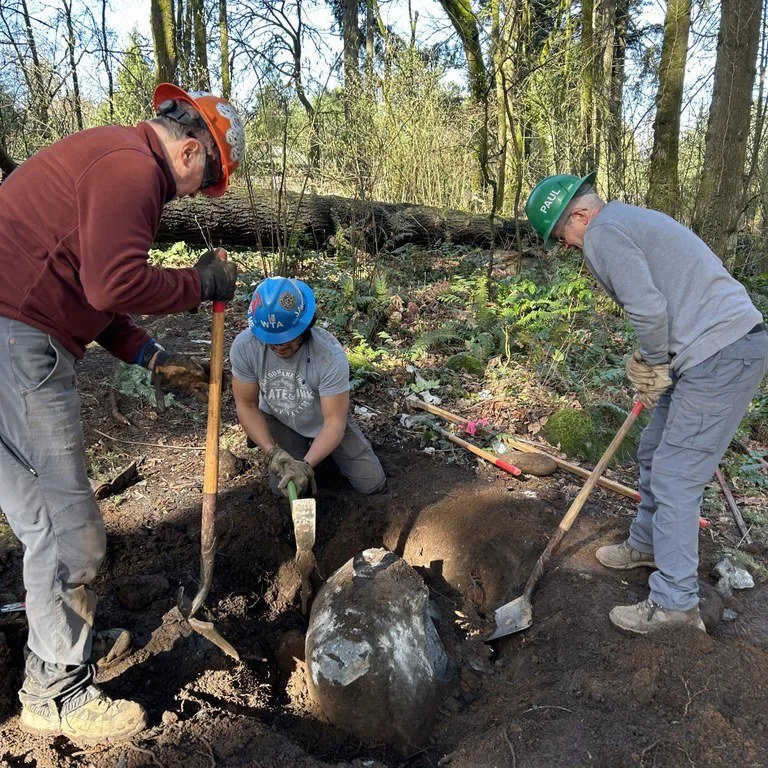WTA - New Vancouver trail lowers barriers to nature, trail work
Shared post from Washington Trails Association - written by Linnea Johnson
Behrens Woods embodies the power of a local park to connect people with nature, with each other and even with hope for the future.
Cheers abounded from the hard hat-clad crowd as WTA volunteer crew leader Emma Royce cut the ribbon on Washington’s newest accessible trail: Behrens Woods in Vancouver, Washington.
Behrens Woods is in Vancouver’s Bella Vista neighborhood, nestled between a multi-family apartment complex and the backyards of single-family homes. The Columbia River flows less than half a mile away as the crow flies, but Highway 14 cuts between the neighborhood and river, putting riverside nature out of reach by foot.
At two acres, Behrens Woods may not offer the long hiking trails or sweeping views of nearby Silver Star Mountain. But the worth of this park and its new trail — which meets U.S. Forest Service standards for universal accessibility — is incalculable for the surrounding community.
Volunteers moved boulders and hauled between 50 and 75 tons of gravel to complete 50 yards of wheelchair-friendly tread!
Forests provide countless health benefits to those who spend time in them. They can even benefit people who never visit, but live nearby. But this local wood, and others like it around the state, have created countless new opportunities for people to connect with each other and get more involved in the community while caring for a place they’ll return to again and again.
NatureSpaces: Bringing locals’ commitment and WTA’s expertise together build the trails neighborhoods need
Vancouver has a good thing going on. In 2023, the city kicked off the NatureSpaces pilot program, which gets community members involved with design and maintenance projects in public green spaces, with shared benefits for both humans and habitat.
Hailey Heath, Citywide Volunteer Coordinator for the City of Vancouver, shared that as of May 2024, volunteers had spent over 2,300 hours caring for 11 different sites across the city.
Volunteers Mike, Varun and Jan at Behrens Woods. Photo by Stasia Honnold.
NatureSpaces sites are chosen carefully, through an approach that examines equity factors such as neighborhoods’ health disparities and current access to nature, as well as opportunities to nurture biodiversity and the potential to get existing volunteer groups involved.
The city selected Behrens Woods as one of the first three NatureSpaces sites for four key reasons. First, the park plays an important role in improving air quality for a neighborhood that sits near a major highway. Second, it’s near a multi-family housing complex, and can therefore put nature within reach for more people. Third, a committed group of neighbors, led by Varun Rathi, had already been working with the city to remove ivy and steward the park’s vegetation. Lastly, the forest had strong potential to serve as an ecological model for future projects.
“With a little effort and work, we knew we could consider it a healthy urban forest that we could reference. If you want to see a healthy urban understory, go to Behrens Woods,” said Hailey.
Building a new, accessible trail takes both expert trail design knowledge and lots of people power. So, having done trail work before herself, Hailey knew who to reach out to: Washington Trails Association.
Designing for universal access — and a little whimsy
Before this year, the paths through Behrens Woods were solely social trails that neighbors used to cross through the park. While they helped folks get from point A to point B, the trails weren’t accessible to everyone and didn’t facilitate meandering walks through the woods. So, with NatureSpaces funding, the City of Vancouver brought in WTA to redesign the trail to meet U.S. Forest Service Trail Accessibility standards — and to leverage our additional volunteer power to bring the project to fruition.
Stasia Honnold teaches new trail construction techniques to volunteers at Behrens Woods. The close-in location gave the crews more time to learn together. Photo by Varun Rathi.
Ryan Ojerio, Southwest Washington regional manager and Stasia Honnold, Southwest regional coordinator, took neighbors’ needs, accessibility factors and a little fun into account when designing the new trail system.
The entire crushed gravel trail needed to be at least three feet wide, have gentle turns and a grade no greater than 5 percent. These universal design characteristics would make the trail more accessible not only to people in wheelchairs, but also to families with strollers, folks of all ages and abilities who prefer a gentle walk and groups who simply want to walk side by side.
As Stasia measured grade throughout the park, she also looked out for elements of beauty and joy along the route.
“I was thinking, ‘this is a cool tree that it would be fun to walk past,’ and looked for other features that would make [the park] interesting to walk or roll together,” said Stasia.
Photo by Wanda Cantrell.
Find Wheelchair-friendly hikes
As part of our commitment to making trails more accessible to people with disabilities, WTA added a filter for wheelchair-friendly hikes to our Hiking Guide in 2022. We continue to add detailed trail information for hikers who use wheelchairs.
Ryan and Stasia wanted to ensure that the trails would continue to meet neighbors’ needs, while also opening access for people to explore and stay a while in this forest haven.
“There are people who want to pass through the park, who want to go straight through ... but then, for people who want to have an experience and spend time seeing the trees, that pathway should be more circuitous,” said Ryan.
The final trail design kept the straight trail that crosses the park diagonally while adding in a meandering perimeter trail.
“It’s got whimsy! It’s playful,” said Ryan.
The result aligns with the city’s vision for Behrens Woods.
“Not only are we encouraging people to come in at all ability levels, but we’re also protecting those former social trails,” said Hailey.
Local parks make trail work — and its mental health benefits — more accessible
WTA’s trail volunteers regularly say that volunteering is fun and rewarding. Increasing evidence suggests that volunteering outdoors — especially in ways that help protect or restore the natural environment — is good for our mental health, and can even serve as an antidote to climate grief and anxiety. Hailey sees the benefits of taking action firsthand.
“I read a lot about climate change and the loss of biodiversity. There’s a lot of really bleak news about our Earth. This offers up that chance for people to do something. This really gives a chance for community members to come out and make a difference and an impact in a time when we need hope,” said Hailey.
Work parties at Behrens Woods involved lots of gravel … and lots of laughs! Photo by Jim Clute.
At WTA, we believe that everyone should have access to opportunities to give back to trails and care for nature. One of the ways we're reducing barriers to volunteering is hosting more work parties on local trails. Places like Behrens Woods make it possible for folks to volunteer — and lead — who otherwise not due to time or transportation constraints or differing comfort levels in the outdoors.
For folks who are new to Washington and WTA
Kathy Garmus moved to Vancouver in March with her wife and cat.
“Both of us have been to all 50 states, and I think Washington’s the most beautiful,” said Kathy.
They were on a walk in Behrens Woods one summer day when they stumbled on a crew of folks in hard hats shuttling gravel up and down the trail in wheelbarrows. Kathy walked up to the group and asked the volunteers what they were up to, and something clicked.
Stasia Honnold and volunteers celebrate a successful work party at Behrens Woods. Photo by Stasia Honnold.
“I had been looking for volunteer opportunities in the community anyway because I like doing volunteer work. And I like physical labor. So, I was like, ‘Oh my god, this is perfect! Where do I sign up?’ When we got home that afternoon, I went online, promptly joined WTA and started looking for opportunities where I might be able to help out,” said Kathy.
Kathy signed up for two work parties at Behrens Woods, a park in her own neighborhood, and had a blast.
“I was most surprised by how welcome the other WTA volunteers made me feel as a newcomer. I know many of them had so many hours working for WTA, and I just showed up. But I was made to feel welcome and appreciated. Obviously, I’ll be back!” said Kathy.
A perfect place to introduce young volunteers to trail work
Rosemary Perkins has been volunteering with WTA for nearly a decade and has worked on all different kinds of trails throughout Southwest Washington.
Behrens Woods presented a unique opportunity for Rosemary to get her 12-year-old brother Geoffrey involved, too.
Volunteers Rosemary Perkins and her brother Geoffrey, 12, each celebrated a milestone at Behrens Woods: Rosemary’s 25th work party and Geoffrey’s 5th. Photo by Emma Royce.
"With Geoffrey being still pretty new to trail work and, being on the younger side, not being ready for 10-mile hikes, it was a pretty accessible work party for both of us since it was right here in town. It was a really good opportunity for him to get his feet wet with trail work and try out new things,” said Rosemary.
Rosemary remarked how meaningful it was to work on trail together as siblings. One memorable day at Behrens Woods, Rosemary earned her WTA vest (signifying her 25th work party) and Geoffrey received his own personalized green hat (celebrating his 5th work party). But the milestones weren’t all that made Behrens Woods special — the sibling duo also enjoyed seeing the progress made over time.
“That’s one of the reasons I really like working on urban trails: the ability to go back and see the trail and see it being used over time, and being more involved with the construction of the trail. When we did our very first work party at Behrens Woods, there was still a section without any gravel laid. But then, by the time we finished up on our last day, it was connected — there was a whole route you could do. It was really cool to be able to see the progression of it and actually see it finished,” said Rosemary.
As a volunteer, she also loves contributing to a park that will put nature in reach for more people.
“I really like being able to make the experience more accessible for people who can’t necessarily just hop in their car and drive an hour and a half to get to a really beautiful mountain hike. Or, people who can’t physically do a longer hike but still want to be around beautiful trees like there are at Behrens Woods.” — Rosemary Perkins, volunteer
Crew leader James Alexander works with volunteers to move a boulder out of the trail.
A place for local leaders to build skills and community
Not only do local trails open up opportunities for new volunteers to try trail work — they also offer opportunities for new leaders to build their skills and gain confidence before leading work parties in more distant locations.
WTA recently presented two new Southwest Washington volunteer crew leaders, Emma Royce and Jim Clute, with their blue hats. These new leaders led four out of the six work parties at Behrens Woods.
“It’s a great place to practice leadership. It’s like the difference between learning rock climbing at an indoor gym in town versus saying “I’m going to go learn up in the mountains away from everything. So, there are lots of people and resources close by,” said Ryan.
“The start of a lifelong love of the outdoors”
Behrens Woods embodies the power of a local park to connect people with nature, with each other and even with hope for the future.
This project was made possible through a strong collaboration between the city’s NatureSpaces program, WTA crews and a neighborhood group of volunteer park stewards. Community volunteers joined WTA work parties, and they continue to visit the park regularly to remove ivy and check in on the native vegetation.
Working on trails is also an investment in a world where future generations grow up connected with the natural world and the countless health benefits it offers so freely.
New volunteer Kathy said it best:
“I’d like to think that because of the work WTA did there, that more people will discover it and walk the trails. And maybe because it’s more accessible and easy to walk through, more people will walk there, and perhaps it’ll be a young child’s first introduction to a woodland landscape. The start of a lifelong love of the outdoors might be Behrens Woods,” said Kathy.
No matter your experience with trail work and hiking, you are welcome on trail with WTA! Find a work party near you to make friends and make difference for your community.

